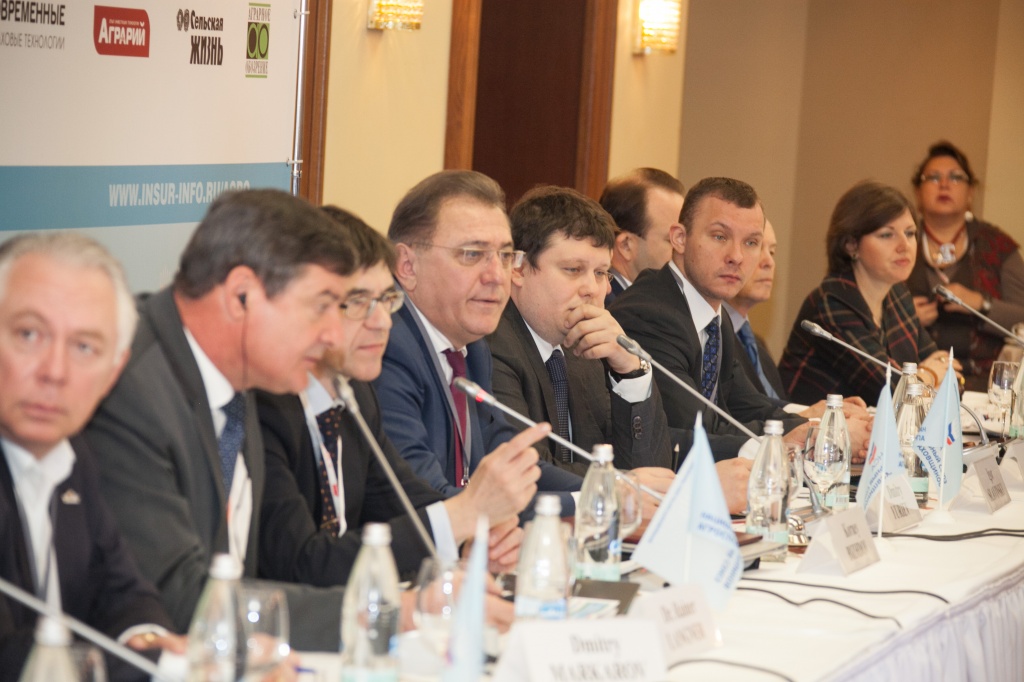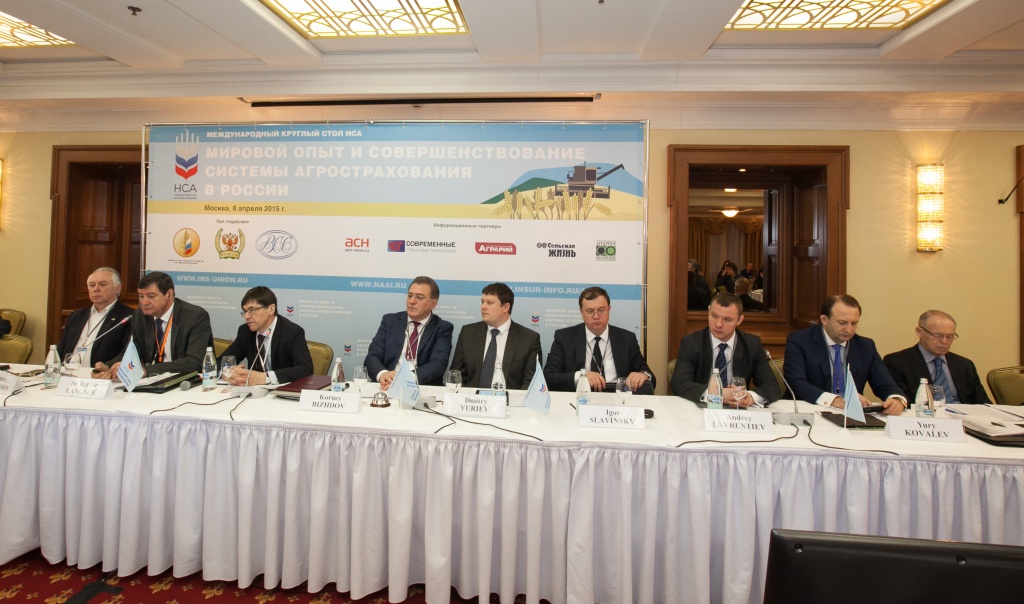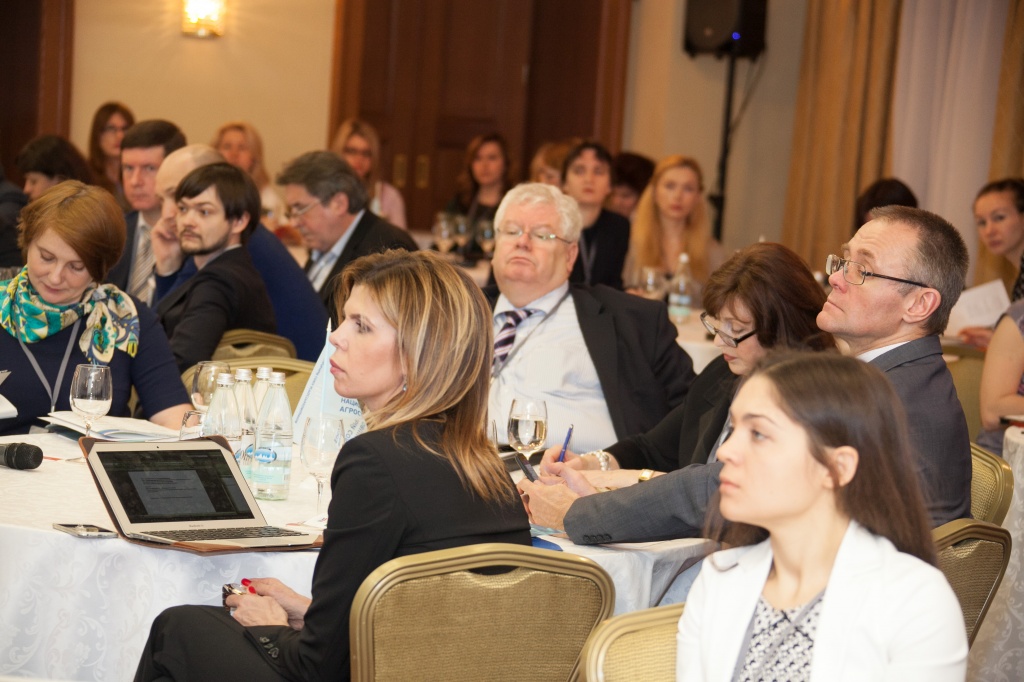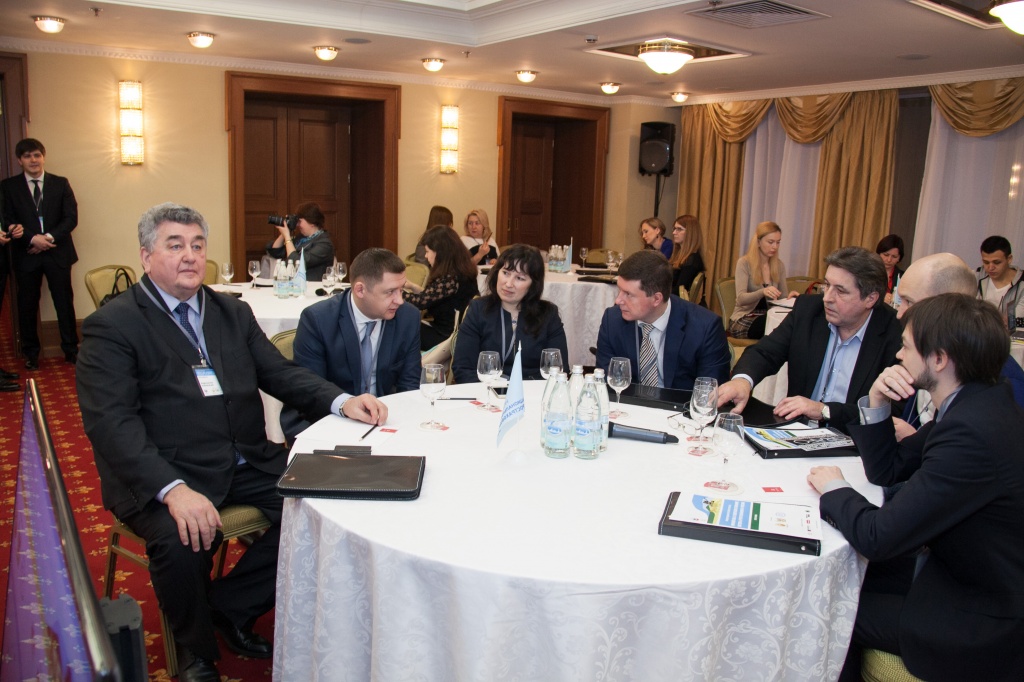International round table of NAAI: agricultural insurance in Russia prepares for a new stage
The development of agricultural insurance in Russia is in the mainstream of worldwide trend though now its characteristics are not adequate to agribusiness market size. While in the world the share of the insured farmlands makes 38%, and in a number of countries about 90% of crops are insured, Russia still can’t make more than one fifth of cultivated areas being insured. To propel agricultural insurance to the next level, we need to solve a series of tasks connected, first of all, with the infrastructure development and to improve management control, as well as to offer diverse terms of insurance taking into account some regional features. Such proposals were made by participants of the International round table "World experience and improvement of agricultural insurance in Russia" which took place in Moscow on April 8.The round table which has already become the fourth agricultural insurance event of international rank organized by the National Association of Agricultural Insurers (NAAI), was characterized by an active and constructive dialogue, in which representatives of the Ministry of Agriculture and State Duma of the Russian Federation, Bank of Russia, the Eurasian Economic Commission, regional agribusiness of the Russian Federation, the international and Russian insurance and reinsurance markets, rural producers organizations took part.
Greeting to the participants of the round table was sent by the Minister of Agriculture of the Russian Federation Nikolay Fedorov who noted: "Agricultural insurance with state support plays one of key roles in providing a sustainable development of agro-industrial complex in our country. It’s gratifying to emphasize that Russian agricultural producers start to understand the ultimate importance of modern schemes of loss coverage in adverse climatic conditions. The interaction history with the National Association of Agricultural Insurers in carrying out the agricultural insurance scheme with state support shows that the system of agricultural insurance in our country is not just viable, but also possesses a considerable potential." Igor Yurgens, the president of the All-Russian Insurance Association (ARIA), in his welcome speech also emphasized that agricultural insurance development "requires permanent, responsible and intelligent efforts of all parties of a triangle “state - business - consumer". Having recognized "the outstanding work" of NAAI in the development of agricultural insurance in Russia, the head of ARIA also expressed his hope that the regulator will support the insurance interests initiative on granting NAAI the status of the all-Russian association.
The results of agricultural insurance development in Russia were presented by the Deputy Minister of Agriculture in Russia Dmitry Yuryev at the round table. He made the point that in 2014 there was a substantial growth in a number of participants of state-supported agricultural insurance: the number of the farms which insured crop increased by 13% and exceeded 5.8 thousand while in animal farming the growth in client base made 42% (up to 526 farms).The percentage of the insured areas made 17.7%, totally 12.8 million hectares of crops were insured. As for livestock insurance, the percentage of insured livestock grew from 7% to 16.6%. At the same time, the demand for insurance can slacken in 2015 due to reduction of current assets of agricultural producers caused by common economic processes, noted the Deputy Minister, making a point that the Ministry expects transparent work from insurance companies.
This year some alterations to agricultural insurance scheme providing coverage extension of agricultural producers have been made in Russia, and starting from 2016, according to new edition of the Federal Law on State Support to Agricultural Insurance, a serious strengthening of government control over agricultural insurers is expected, so a transition to a merged association of agricultural insurers is provided. The transition to a merged association of agricultural insurers is carried out under the supervision of the insurance regulator, the Bank of Russia. Now the Bank of Russia has created a working group which task is to prepare a number of regulations. "Its task is to provide a segue to a merged association of agricultural insurers; the work is being carried out and we will succeed.", – declared at the round table the Deputy Head of Department Regulating Insurance Market of the Bank of Russia, Olga Shelepneva .
All in all, about 38% of 1.5 billion hectares of farmland in the world are insured, pointed out Dr. Rainer Langner, the board member of the International Association of Agricultural Production Insurers (AIAG), the Chairman of German Agricultural Insurers Consortium and the Chief Manager of one of the largest European agricultural insurance companies - Vereinigte Hagel. However, the agricultural insurance market continues growing rapidly – also due to the fact that government takes measures to boost subsidizing and development of the branch in the largest world markets, including China which is practically booming agricultural insurance. The particular importance of agricultural insurance is explained by the fact that the number of claimed losses in agriculture is bigger, than in all other sectors of economics; and both the farmer and the state benefit from subsidizing of insurance.


Agricultural insurance development and its integration at the level of the countries of the Eurasian Economic Union (EEU) is also one of the tasks of the Eurasian Economic Commission (EEC) which delegation was also presented at the meeting. The Deputy Director of Agro-industrial Policy Department of EEC Anna Buts noted that only one of the four existing members of EEU – Armenia – still doesn't have any of agricultural insurance subsidizing. A bill providing a reform of the state support scheme and transition from subsidizing of insurance indemnities to subsidizing of insurance premiums is being prepared in Kazakhstan now.
Agricultural insurance development in Russia doesn't correspond to scales of the national agribusiness, the president of NAAI, Korney Bizhdov specified. "According to the UN World Food Programme, by volume of land resources the Russian Federation takes the 4th place, by agribusiness assets - the 7th, – he emphasized. – At the same time, according to the international reinsurers the agricultural insurance market of the Russian Federation took the 22nd place by volume in the world two years ago”.
The agricultural insurance market of the EEU countries was also represented by Belarus at the meeting, the country where crop and livestock insurance is compulsory. The Head of the Department of legal entities’ risks insurance of the Belarusian state company "Belgosstrakh" Olga Koroleva spoke about working of this scheme. She paid special attention to the issue of agricultural insurance strengthening under the conditions of irregularity of subsidizing (95% payment of insurance premium is provided by state, but practically subsidizing can reach about 60%) – in spite of the fact that loss ratios of agricultural insurance in Belarus ranges from 26 to 286%, "Belgosstrakh" pays indemnities in full every year.
At the round table the international insurance and reinsurance expert Vladimir Kalinin also presented Spanish experience in organizing agricultural insurance – the Agroseguro scheme providing about 500 thousand policies with annual premium of about 675 million euros and uniting 29 insurers as co-insurers. The scheme is characterized by a high level of centralization regarding product development and other insurance processes, as well as excess of loss reinsurance.
The subject of agricultural risk reinsurance in Russia was absolutely and irrespectively considered by Andrey Lavrentyev, the Deputy Director of the Aon Benfield Moscow Company, and the business division of one of the world's largest insurance and reinsurance brokers. He noted that agricultural risk reinsurance capacity in the global market grows simultaneously with the booming of agricultural insurance market which trebled in the last 6 years, whilst new players come to the market, and terms of reinsurance are being eased. "The global market of reinsurance has more than sufficient capacity to protect agricultural portfolios of the Russian companies", – the broker assured.


The issue of functioning of one merged association of agricultural insurers is connected with self-regulation in the insurance market in general, the preparation for which is also carried out legislatively, said in his speech Dmitry Markarov, the General Director of JSC “Rosgosstrakh”(“Rosgosstrakh" is the leader of agricultural insurance market in 2014, the company has more than 50 years' experience in agricultural risks insurance). Dmitry Markarov especially noted the necessity of coordination of state assistance in emergency and availability of insurance for agricultural producers.
Russia still can't deprive agrarians of direct state indemnities in emergency and replace it by insurance, but the amount of agricultural insurance state funding, as well as the amount of agricultural subsidizing in Russia in general, differs greatly downward compared to the world practice, and this fact must be seen as a boundary condition, – this is the opinion of Gennady Kulik, member of the State Duma of the Russian Federation and a famous agrarian expert. In his speech he supported the transition to a differentiated approach when defining insurance terms taking into account regional features and, perhaps, branches of livestock farming and crop production; he spoke for organization of transparent adjustment of insurance claims and for introduction of the systematized requirements to meteorological information. "Don't delay transition to one merged association of agricultural insurers, for this will ease the work greatly", - highlighted the Deputy.
The Head of the Agribusiness Committee of the Civic Chamber of the Russian Federation and the Expert of the All-Russian People’s Front working group "Honest and effective economy" Evgenia Uvarkina who is also a representative of the Chernozem Region Agribusiness and the board member of the National Dairy Producers Union “SOYUZMOLOKO”, supported the centralization of work on the independent examination connected with adjustment of insurance claims. She suggested considering agricultural insurance development at the Civic Chamber level.
Greeting to the participants of the round table was sent by the Minister of Agriculture of the Russian Federation Nikolay Fedorov who noted: "Agricultural insurance with state support plays one of key roles in providing a sustainable development of agro-industrial complex in our country. It’s gratifying to emphasize that Russian agricultural producers start to understand the ultimate importance of modern schemes of loss coverage in adverse climatic conditions. The interaction history with the National Association of Agricultural Insurers in carrying out the agricultural insurance scheme with state support shows that the system of agricultural insurance in our country is not just viable, but also possesses a considerable potential." Igor Yurgens, the president of the All-Russian Insurance Association (ARIA), in his welcome speech also emphasized that agricultural insurance development "requires permanent, responsible and intelligent efforts of all parties of a triangle “state - business - consumer". Having recognized "the outstanding work" of NAAI in the development of agricultural insurance in Russia, the head of ARIA also expressed his hope that the regulator will support the insurance interests initiative on granting NAAI the status of the all-Russian association.
The results of agricultural insurance development in Russia were presented by the Deputy Minister of Agriculture in Russia Dmitry Yuryev at the round table. He made the point that in 2014 there was a substantial growth in a number of participants of state-supported agricultural insurance: the number of the farms which insured crop increased by 13% and exceeded 5.8 thousand while in animal farming the growth in client base made 42% (up to 526 farms).The percentage of the insured areas made 17.7%, totally 12.8 million hectares of crops were insured. As for livestock insurance, the percentage of insured livestock grew from 7% to 16.6%. At the same time, the demand for insurance can slacken in 2015 due to reduction of current assets of agricultural producers caused by common economic processes, noted the Deputy Minister, making a point that the Ministry expects transparent work from insurance companies.
This year some alterations to agricultural insurance scheme providing coverage extension of agricultural producers have been made in Russia, and starting from 2016, according to new edition of the Federal Law on State Support to Agricultural Insurance, a serious strengthening of government control over agricultural insurers is expected, so a transition to a merged association of agricultural insurers is provided. The transition to a merged association of agricultural insurers is carried out under the supervision of the insurance regulator, the Bank of Russia. Now the Bank of Russia has created a working group which task is to prepare a number of regulations. "Its task is to provide a segue to a merged association of agricultural insurers; the work is being carried out and we will succeed.", – declared at the round table the Deputy Head of Department Regulating Insurance Market of the Bank of Russia, Olga Shelepneva .
All in all, about 38% of 1.5 billion hectares of farmland in the world are insured, pointed out Dr. Rainer Langner, the board member of the International Association of Agricultural Production Insurers (AIAG), the Chairman of German Agricultural Insurers Consortium and the Chief Manager of one of the largest European agricultural insurance companies - Vereinigte Hagel. However, the agricultural insurance market continues growing rapidly – also due to the fact that government takes measures to boost subsidizing and development of the branch in the largest world markets, including China which is practically booming agricultural insurance. The particular importance of agricultural insurance is explained by the fact that the number of claimed losses in agriculture is bigger, than in all other sectors of economics; and both the farmer and the state benefit from subsidizing of insurance.


Agricultural insurance development and its integration at the level of the countries of the Eurasian Economic Union (EEU) is also one of the tasks of the Eurasian Economic Commission (EEC) which delegation was also presented at the meeting. The Deputy Director of Agro-industrial Policy Department of EEC Anna Buts noted that only one of the four existing members of EEU – Armenia – still doesn't have any of agricultural insurance subsidizing. A bill providing a reform of the state support scheme and transition from subsidizing of insurance indemnities to subsidizing of insurance premiums is being prepared in Kazakhstan now.
Agricultural insurance development in Russia doesn't correspond to scales of the national agribusiness, the president of NAAI, Korney Bizhdov specified. "According to the UN World Food Programme, by volume of land resources the Russian Federation takes the 4th place, by agribusiness assets - the 7th, – he emphasized. – At the same time, according to the international reinsurers the agricultural insurance market of the Russian Federation took the 22nd place by volume in the world two years ago”.
The agricultural insurance market of the EEU countries was also represented by Belarus at the meeting, the country where crop and livestock insurance is compulsory. The Head of the Department of legal entities’ risks insurance of the Belarusian state company "Belgosstrakh" Olga Koroleva spoke about working of this scheme. She paid special attention to the issue of agricultural insurance strengthening under the conditions of irregularity of subsidizing (95% payment of insurance premium is provided by state, but practically subsidizing can reach about 60%) – in spite of the fact that loss ratios of agricultural insurance in Belarus ranges from 26 to 286%, "Belgosstrakh" pays indemnities in full every year.
At the round table the international insurance and reinsurance expert Vladimir Kalinin also presented Spanish experience in organizing agricultural insurance – the Agroseguro scheme providing about 500 thousand policies with annual premium of about 675 million euros and uniting 29 insurers as co-insurers. The scheme is characterized by a high level of centralization regarding product development and other insurance processes, as well as excess of loss reinsurance.
The subject of agricultural risk reinsurance in Russia was absolutely and irrespectively considered by Andrey Lavrentyev, the Deputy Director of the Aon Benfield Moscow Company, and the business division of one of the world's largest insurance and reinsurance brokers. He noted that agricultural risk reinsurance capacity in the global market grows simultaneously with the booming of agricultural insurance market which trebled in the last 6 years, whilst new players come to the market, and terms of reinsurance are being eased. "The global market of reinsurance has more than sufficient capacity to protect agricultural portfolios of the Russian companies", – the broker assured.


The issue of functioning of one merged association of agricultural insurers is connected with self-regulation in the insurance market in general, the preparation for which is also carried out legislatively, said in his speech Dmitry Markarov, the General Director of JSC “Rosgosstrakh”(“Rosgosstrakh" is the leader of agricultural insurance market in 2014, the company has more than 50 years' experience in agricultural risks insurance). Dmitry Markarov especially noted the necessity of coordination of state assistance in emergency and availability of insurance for agricultural producers.
Russia still can't deprive agrarians of direct state indemnities in emergency and replace it by insurance, but the amount of agricultural insurance state funding, as well as the amount of agricultural subsidizing in Russia in general, differs greatly downward compared to the world practice, and this fact must be seen as a boundary condition, – this is the opinion of Gennady Kulik, member of the State Duma of the Russian Federation and a famous agrarian expert. In his speech he supported the transition to a differentiated approach when defining insurance terms taking into account regional features and, perhaps, branches of livestock farming and crop production; he spoke for organization of transparent adjustment of insurance claims and for introduction of the systematized requirements to meteorological information. "Don't delay transition to one merged association of agricultural insurers, for this will ease the work greatly", - highlighted the Deputy.
The Head of the Agribusiness Committee of the Civic Chamber of the Russian Federation and the Expert of the All-Russian People’s Front working group "Honest and effective economy" Evgenia Uvarkina who is also a representative of the Chernozem Region Agribusiness and the board member of the National Dairy Producers Union “SOYUZMOLOKO”, supported the centralization of work on the independent examination connected with adjustment of insurance claims. She suggested considering agricultural insurance development at the Civic Chamber level.
Agricultural producers’ viewpoint was expressed by the Heads of two branch associations: the National Union of Swine Breeders (NUSB) and the National Union of Grain Producers (NUGP).The NUSBGeneral Director, Yury Kovalyov, noted that industrial swine breeding has been developing in Russia for 10 years only; now it’s been 10 years since the beginning of the National Agribusiness Project realization, and meanwhile pork production grew more than 5.4 times, moreover, the process of industry growth and consolidation hasn't been finished yet and will continue in years to come. The key problem in swine-breeding is spread of the African swine fever (ASF), he said. Since 2008 when the ASF virus appeared in the Russian Federation it has mostly affected small farms, but in 2014 a number of large modern enterprises of the leading companies in the market were hard hit by this virus. Only over the past year the enterprises had to slaughter 250 thousand head of pigs in the Pskov, Tula, Voronezh and Oryol Regions. At that about 35% of pig stock is insured in pig industry in Russia.
The NUGP General Director, Vyacheslav Golov, noted that agricultural insurance was defined as top-priority industry at the ordinary congress of the NUGP in March. He listed out a number of problems, the most important of which are:
- a rudimentary development state of some institutions, such as independent examination,
- a credibility gap between agricultural producers and agricultural insurers,
- difficulties with obtaining of loans used for insurance premium payments also,
- agrarians’ problems caused by subsidizing delays.
Apart from that, he noted that the technique of determination of average five-year yield has to be refined with due account for variety changing and possible yield declines caused by crop failures over the past few years.
The representatives of two leading agrarian regions - rapidly developing agricultural insurance - Krasnodarskiy Krai and Belgorodskaya Oblast also explained the viewpoint of territorial entities of the Russian Federation on problems and prospects of agricultural insurance development at the local level. The Head of Financial and Stock Market Department of Krasnodarskiy Krai (the key player in the agricultural insurance market in 2014), Igor Slavinsky, detailed the work of Agricultural Insurance Development Department and noted that it seemed quite wrong to decrease the role of heads of insurers’ regional branches which is characteristic for the last few years. The representative of Agribusiness Department of the Belgorod Region, Larisa Parkhomenko reported that in 2014 the region managed to treble the percent the insured livestock up to 43%.
The development of independent examination in agricultural insurance became one of the practical questions. The Head of State Funding Federal Agency of State Support to Agribusiness Insurance, Alexander Gorbunov informed about the growing number of independent experts; the certification of independent experts in livestock insurance is being prepared for the first time this year. The special guest of NAAI, a very experienced independent agricultural insurance expert, Yury Volovik, turned the attention to the necessity of developing technologies of remote land sensing applied in the international markets in independent examination.
The NUGP General Director, Vyacheslav Golov, noted that agricultural insurance was defined as top-priority industry at the ordinary congress of the NUGP in March. He listed out a number of problems, the most important of which are:
- a rudimentary development state of some institutions, such as independent examination,
- a credibility gap between agricultural producers and agricultural insurers,
- difficulties with obtaining of loans used for insurance premium payments also,
- agrarians’ problems caused by subsidizing delays.
Apart from that, he noted that the technique of determination of average five-year yield has to be refined with due account for variety changing and possible yield declines caused by crop failures over the past few years.
The representatives of two leading agrarian regions - rapidly developing agricultural insurance - Krasnodarskiy Krai and Belgorodskaya Oblast also explained the viewpoint of territorial entities of the Russian Federation on problems and prospects of agricultural insurance development at the local level. The Head of Financial and Stock Market Department of Krasnodarskiy Krai (the key player in the agricultural insurance market in 2014), Igor Slavinsky, detailed the work of Agricultural Insurance Development Department and noted that it seemed quite wrong to decrease the role of heads of insurers’ regional branches which is characteristic for the last few years. The representative of Agribusiness Department of the Belgorod Region, Larisa Parkhomenko reported that in 2014 the region managed to treble the percent the insured livestock up to 43%.
The development of independent examination in agricultural insurance became one of the practical questions. The Head of State Funding Federal Agency of State Support to Agribusiness Insurance, Alexander Gorbunov informed about the growing number of independent experts; the certification of independent experts in livestock insurance is being prepared for the first time this year. The special guest of NAAI, a very experienced independent agricultural insurance expert, Yury Volovik, turned the attention to the necessity of developing technologies of remote land sensing applied in the international markets in independent examination.
"NAAI thanks everybody who has taken part, – the president of NAAI, Korney Bizhdov, declared. – The round table turned out to be very representative, and the hot discussion showed that agrarians, and government representatives of all the levels, and insurers as well are interested in a more systematic approach to fulfillment of a number of strategic tasks."